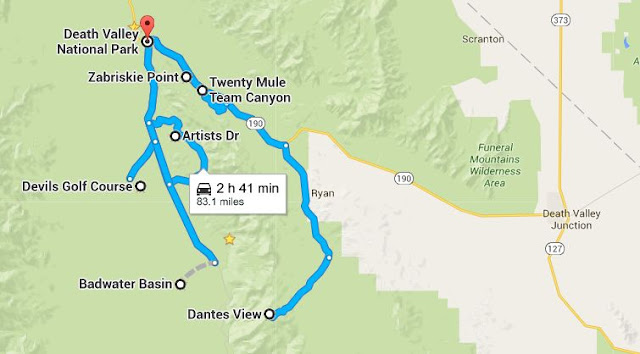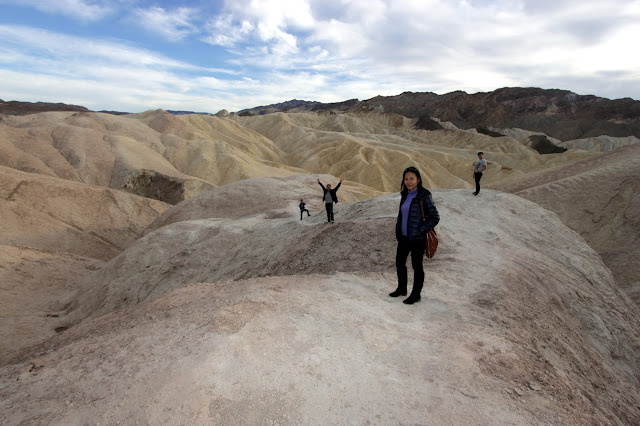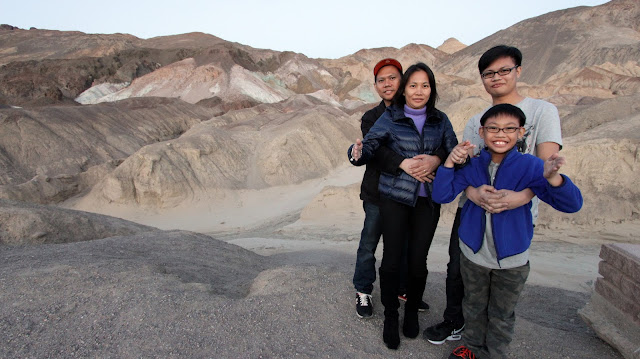 |
| Badwater Basin, another perfect spot for stargazing. This was our second sighting of the Milky Way galaxy during our US2015 road trip. |
"You have never really seen the stars till you have seen them in Death Valley. The clear, limpid atmosphere brings them very close. You feel you could reach up and pull them down."
- Bessie Johnson
Here we were, at the point of the lowest elevation (282ft) in North America (Badwater Basin), standing on salt flats in front of the highest point (3,366m) in Death Valley, Telescope Peak, staring into the illuminated night sky with the view of the galaxy that contains our solar system, the Milky Way. And yes, it did feel like we could reach up to them.
- Bessie Johnson
Here we were, at the point of the lowest elevation (282ft) in North America (Badwater Basin), standing on salt flats in front of the highest point (3,366m) in Death Valley, Telescope Peak, staring into the illuminated night sky with the view of the galaxy that contains our solar system, the Milky Way. And yes, it did feel like we could reach up to them.
Eerie.
Breathtaking.
Priceless.
Death Valley National Park, according to the Lonely Planet is a land of superlatives - holds the US record for hottest temperature (57C), has the lowest point in North America (Badwater basin at 282ft below sealevel), and is the largest national park outside Alaska (with over 5000sq miles). That's about 18 times as big as Singapore. It would probably take us days, even weeks or months, to explore the whole park! For this trip, we settled for the park's major attractions that are within a few kilometers from Furnace Creek, where we settled for the night.
Having limited time in a national park can be quite challenging. I think with travelling that's always been one of the biggest challenges for us. So many things to see and do with so little time. For this particular leg of our trip it meant we had to give up some interesting places like The Race Track (mysterious for the stones with long tracks trailing behind them scattered around the area) and Ubehebe Crater (which resulted from a volcanic explosion, different from Meteor Crater which was caused by, what else, but a meteor). We've narrowed down our list and planned the ultimate Death Valley road trip, given less than 24 hours to explore.
 |
| Here is the map of the places we've visited at Death Valley National Park. All 83 miles of road trip. |
On Day 16 we left Las Vegas, followed NV-160W all the way to Death Valley Junction and continued to CA-190W all the way inside Death Valley National Park. We passed by one of the park's entrance booths where visitors can purchase park admission tickets. Entry to the park costs USD20 but thanks to the Annual Pass we bought, admission to the Death National Park was included. We did stop by just to see what was in there and to have a short break to stretch our legs. Then we were on the road again. The trip from Las Vegas to Death Valley Junction was about 2 hours (93 miles). And another 40 minutes (31 miles) to get to our first stop. Yeah, the park is that vast that getting from one point to the other would take you more than just a few minutes.
First Stop: DANTE'S VIEW
Standing at 5,745ft, not the highest peak but definitely the most breathtaking viewpoint in the park. Guidebooks said this place offers one of the best sunrises in the park but since we didn't have time for sunrise views, and this was the first view point / attraction along the way, it made sense to put it at the top of our list.
As the saying goes, first impressions last. At Dante's View, our first impression of Death Valley made us want to see more of the attractions at the park. It was a short hike up on paved road to Dante's View from the car park. Getting to the top gave us this view of the vastness of Badwater Basin with the Panamint Mountains as the backdrop. We enjoyed the view, imagining the sun setting behind the mountains and the horizon golden orange in color. Something like the sunset view while we were at the Observation Tower in Las Vegas but this time much closer to the mountains.
Second stop: TWENTY MULE TEAM CANYON
About 19 miles from Dante's View, we turned into this one-way loop, 2.7 mile, mostly unpaved road. This was named after the twenty mule team of 18 mules and 2 horses pulling large wagons full of borax out of Death Valley from 1883-1889.
After going through the loop I can say we had a totally different impression of this so called "unworldly badlands".
 |
| a view of the colorful mountains along the way |
Third Stop: ZABRISKIE POINT
Another famous spot for sunrise or sunset. This is said to be the most famous view point in the park. Part of the Amargosa Range, it is composed of from dried up Furnace Creek Lake about 5 million years ago. Zabriskie Point was built by the Pacific Borax Company in the 1920s and named after the company's vice president and general manager, Christian Zabriskie.
From the parking lot it's an easy uphill walk on paved road to get to the view point where visitors can admire colorful ravines and hills at the edge of the Black Mountains.
 |
| overlooking the seemingly small but actually high and vast range of hills with light colors surrounding the dark colored hill tops |
 |
| Overlooking MANLY BEACON (pointed peak at the far left end of the photo), the main reason behind the construction of Zabriskie Point - a stop for visitors on automobiles to see this prominent landmark |
 |
| our attempt to walk down some of the nearby trails. |
You can have the option to do the Badlands Loop which is a 2.5mile hike which starts and ends at Zabriskie Point.
 |
| Photo by Kelvin: panoramic view from Zabriskie Poiint |
THIRD STOP: FURNACE CREEK
Before exploring the rest of the attractions on our list for the day, we headed to Furnace Creek to check in to our accommodation for the night.
Elevation of the village: 190 feet below sea level
 |
| when in the desert, take a photo with dried trees. |
 |
| after checking in and getting our keys, we passed by the main signage for another photo op |
At Furnace Creek there are 3 accommodations to choose from:
- Furnace Creek Ranch - casual, family-like setting; western-themed grounds; average price
- Furnace Creek Inn - elegant hideaway since 1927; four diamond resort; luxurious
- Fiddler's Campground - at USD18 per night, guests can avail of the Ranch’s natural spring-fed swimming pool, shower facility, coin operated laundry and sports courts including a Tennis Court, Shuffleboard, Volleyball, Bocce Ball and Basketball Court; most value for money if you don't mind camping for a few nights
We initially wanted to get somewhere outside since it's cheaper per night - Beatty area was one of the choices - but looking at the next destination in our itinerary it made sense to just stay in the heart of Death Valley. So I booked our accommodation for 1 night at Furnace Creek Ranch thru their website: http://www.furnacecreekresort.com.
We loved the western/classic-theme of the Ranch as it felt we were brought back to the time when the area was still a working Ranch. It was like we were on some Hollywood studio set sans the mules and horses. We also loved the simplicity of the room. There is a convenience shop just across the reception area and also a restaurant where guests can have their own bbq tables. But we had other plans for that night. We quickly grabbed some food to eat (a bit pricey, I should say, but the next shop was hundreds of miles away) and some water and rested for a while. Then we drove back to the badlands to check out the rest of the sights and make it to Badwater basin at night time.
FOURTH STOP: ARTISTS DRIVE
From Furnace Creek, we drove along Hway 190 and turned right to Badwater Road. We headed for the one-way loop scenic drive (9 miles long) along multi-hued volcanic and sedimentary hills. It was mentioned in guidebooks that it was specially photogenic in late afternoon light.
 |
| These look like sugar-coated candy hills! |
 |
| These are some of the less colorful hills viewed from afar |
 |
| and here we were projecting C3P0-like movements. This was the location where R2D2 was abducted by Jawas in Star Wars Episode IV. |
From the colorful hills seen at Artists Drive, we drove 12 miles to the famous salt flats.
FIFTH STOP: BADWATER BASIN
How it was formed: Some two to four thousand years ago this basin was a 30-foot-deep lake. Over the years, the lake evaporated and what was left is what we now see as one- to -five-foot layer of salt.
 |
| my attempt to take a photo of the sign while there was still some sunlight left |
As the sign says, at 282 feet below sea level this is the lowest point in North America. Average temperature here can reach as high as 41.1C and as low as 0.9C. A shallow lake can form after heavy rains but don't usually last for long due to high rate of evaporation.
 |
| at the salt flats waiting for the night sky |
 |
| Behind us stands a mountain a wall-like reminder of where the level of water was thousands of years ago. It actually gives an eerie feeling, at least that was how I felt when I imagined we were actually at the floor of the lake. I could almost feel the flow of water and felt like drowning. Yeah, I have a very wild imagination. That was heightened by the pitch darkness of the surroundings. Take note, we took this shot using slow shutter mode that was why it looked like there was a spotlight on us. |
 |
| "At the lowest spot in North America remember: The sky begins at your feet." - Death Valley National Park Visitor Guide Winter/Spring 2016 |
Death Valley was said to have some of the darkest night skies in the US and was designated as the third and largest International Dark Sky Park by the International Dark-Sky Association. So I would say this should be at the top of your list when you visit Death Valley NP.
It was getting chillier by the minute so we decided to go back to the Ranch and explore the facilities. We've seen a pool when we drove out and we've read that it was a spring-fed swimming pool so it would just be perfect to cap our night.
Although the pool was within walking distance from our room, we decided to bring the car along. We knew it was going to be cold when we come out of the pool. We learned from our experience in New Zealand years ago.
SIXTH STOP: SPRING-FED POOL and BONFIRE
We were lucky the pool was still open when we came back. And the only guests using it was about to leave so we had the pool all by ourselves.
 |
| the natural spring water temperature was just hot enough |
 |
| what a great way to relax at night out in the desert.... overlooking the night sky, too! |
After getting the chills from the pool to the shower room, the bonfires, strategically located within the Ranch premises, looked very much appealing. So we parked the car and walked to the bonfire nearest to our room.
 |
| toasting marshmallows in our minds |
We don't usually have bonfires during our holidays so this one was a treat. We had a good laugh. We shared stories about our Death Valley exprience. We warmed ourselves up (literally)! The bonfire had some calming effect, too.
At some point, the night had to end. We walked back to our room refreshed but ready to hit the beds and looking forward to another long road trip the following day.
DAY 17
Our last day to visit other sites of interest in Death Valley which were on the way to our next destination. What would a visit to Death Valley be without seeing the desert sand dunes? So that was next on our list.
SEVENTH STOP: MESQUITE FLAT SAND DUNES
Belonging to the Mojave Desert region, Death Valley's most accessible sand dunes are near Mesquite Flat. It is also the largest dune field in the park which includes crescent, linear and star shaped dunes.
From Furnace Creek, we followed CA-190 for about 19 miles up to the Mesquite Flat Sand Dunes parking lot. From the parking lot visitors can wander into the sand dunes, limited only by their energy and how much they could take the heat. Luckily, during our visit it was winter time. Although the sun was up there was a generally cool breeze which made the hike up and down the dunes more bearable compared to going there on a different season.
 |
| There was no specific path to follow. There were too many footprints to choose from leading to different areas in the dune field. Most of the time, we created our own path. |
 |
| lucky for me, I decided to wear boots so no worries of getting sand on my feet. |
 |
| There were moments when Ira just wanted to sit down and play with the sand before moving to the next sand dune. We wanted to go as far as we could. |
 |
| at first, Ira was irritated when the sand was going in his shoes, but after realizing there was no way he can avoid it from happening, he embraced the idea and even lay down to get more action (or traction in some instances). |
 |
| long, long way to go... no destination in mind... just roaming freely hoping to get to the top of the highest dune in sight |
 |
| one final group shot before we leave the dunes alone |
I looked back at the parking lot and realized we were farther than we thought we were. We almost couldn't see the cars. We still wanted to try and reach one of the tallest dunes but it was time to head back before we ran out of time. Traversing the sand dunes takes up a lot of time. And time was not we had much of on that day.
 |
| still a long way to go before we could exit the boarders of the Death Valley National Park. We were given a final treat by seeing a couple of foxes by the side of the road. |
"The desert is calling and I must go." - Death Valley quote
We came. We saw. And we're coming back. This desolate but dazzling desert left us wanting for more.
Source of facts:
Wikipedia
www.nps.gov
Death Valley National Park guidebook and newsletter
Death Valley National Park guidebook and newsletter







No comments:
Post a Comment
Please feel free to LEAVE A MESSAGE, ASK A QUESTION or SHARE YOUR EXPERIENCES, too. I would love to hear from you